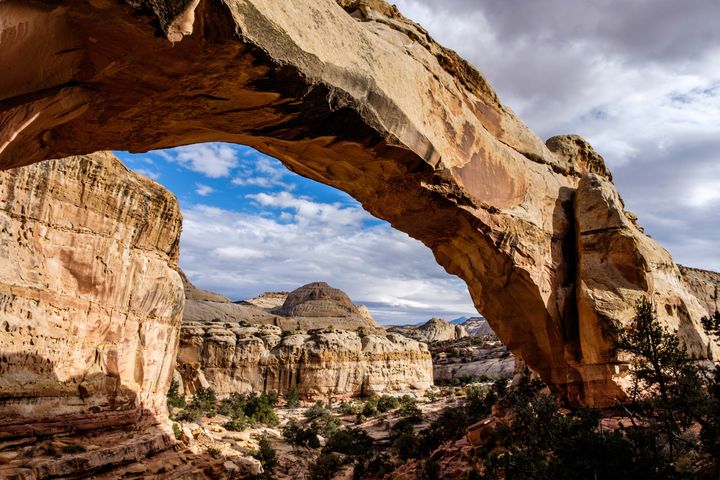
Looking through Hickman Bridge back towards Capitol Dome.
We've often said that all of southern Utah should be protected as national parkland. The entire region is filled with unusual, ornate, and beautiful geologic formations that take shape, color, and texture to a level that is truly beyond comprehension (unless you are a geologist, and if that is the case, you know how special Capitol Reef is.) The crown jewel of the park is Waterpocket Fold, the second largest monocline in North America, a feature that is often described as a "wrinkle" in the Earth’s crust, resembling a coral reef turned inside out.
The park and its surrounding areas protected under the Bureau of Land Management are full of canyons, ridges, buttes, badlands, and monoliths creating a 387-mile playground for modern day explorers while serving up prize shots for landscape photographers. Beyond the natural landscape is a rich cultural past spanning more than a thousand years that was cultivated by the Fremont Indians, and later, Mormon settlers who pioneered the park during the turn of the 19th century. Between easy-to-access areas surrounded by undeniable beauty, boundless backcountry wilderness to explore, and an interesting local history, it is unsurprising that Capitol Reef National Park sees high visitation numbers despite its off-the-beaten-path location.
Like many of the national parks, Capitol Reef is divided into separate and very distinct areas. We've outline them below, there are three, and included some awesome spots to stop at in each of them.
FRUITA RURAL HISTORIC DISTRICT
The Fruita Rural Historic District is the most popular area in the park in terms of visitation. The paved Scenic Drive starting near the visitor center travels 20 miles (out and back) through gorgeous slick rock scenery and provides access along the way to many established trails that trot off into the landscape. There is an important cultural history in this area of the park as well. The village of Fruita was established along the Fremont River by Mormon pioneers in the late 1800s, who found there a rich utopia where they could flourish as the Fremont Indians had many centuries prior. The new settlers planted fruit trees along irrigation lines that were dug by the Fremont culture, trees that still remain today. With that, an apropos first stop...
Fruita Orchards
The Fruita Orchards are a popular place during the spring, summer, and fall when park goers file into the valley to harvest peaches, apricots, and apples. Anyone is welcome to visit open areas to sample and harvest fruit for a small fee. Healthy snacks for the trail!
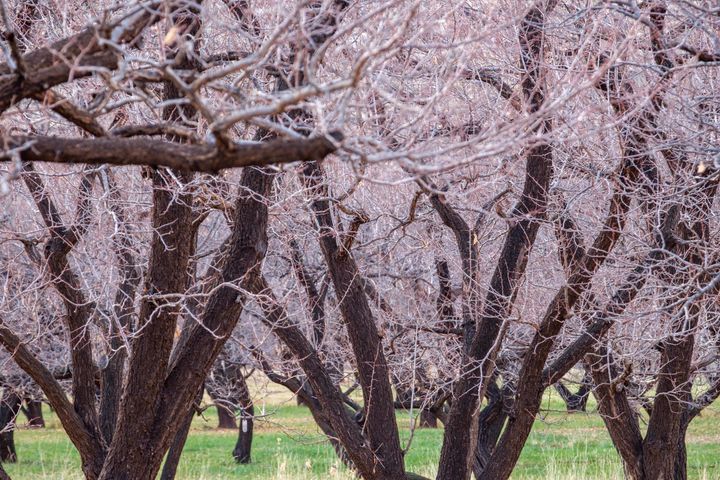
The historic orchards at Fruita during November.
Petroglyphs of the Fremont Culture
Carved into the sandstone formations in Fruita are the Fremont Petroglyphs, chipped rock art depicting animals, people, shapes and other forms indicative of their hunter/gatherer existence. The petroglyphs can be seen on several large panels east of the park visitor center on Hwy 24. There is parking, a boardwalk, and viewing platforms making it easy for all to catch a glimpse of the intriguing relics.
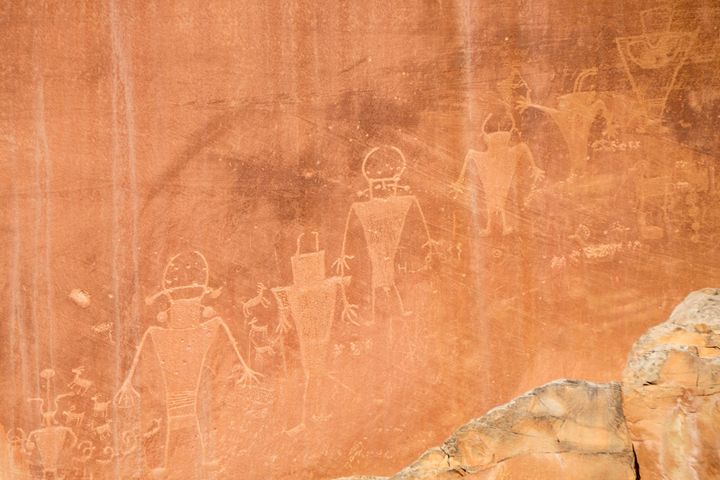
Detail shot of the Fremont Petroglyphs.
Hickman Arch
No visit to a Utah national park could be complete without a sandstone arch framing the scenic landscape. The Hickman Bridge is a 133-foot natural bridge with canyon views in all directions. Getting there is easy with roadside parking on Hwy 24. The trail to the bridge is a cool 1-mile.
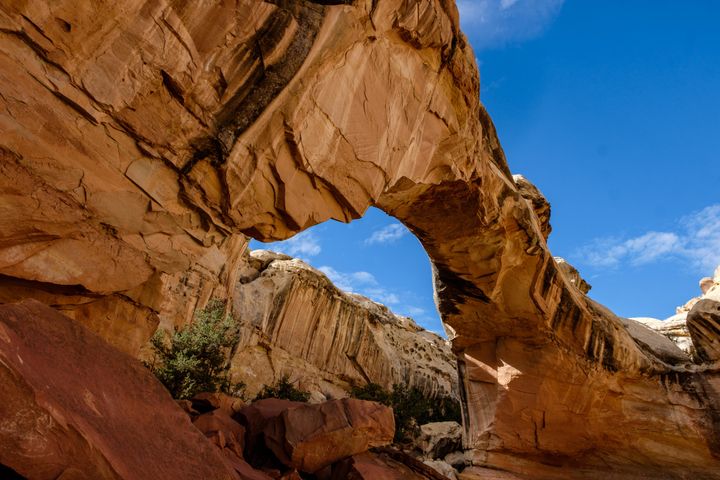
The historic Torrey Log School & Church in the Fruita district of Capitol Reef.
Torrey Log School & Church
The Mormon Church (Church of Jesus Christ of Latter-day Saints, or LDS,) with the help of local settlers built this one room log structure in 1898 using natural resources found in the area, shingles supplied by a local mill, and donations of doors and windows from neighboring communities. The structure was used as a school until attendance superseded space available. The school then evolved into a meeting house for members of the LDS church. The Torrey School & Church is now on the National Register as a historical building.
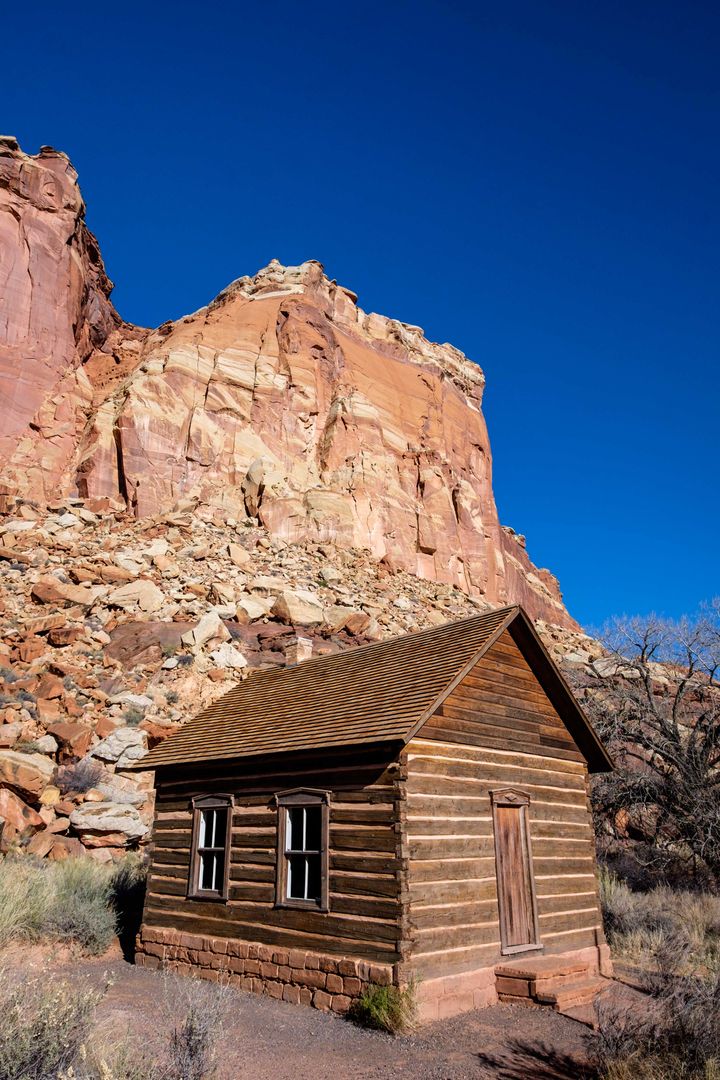
The historic Torrey Log School & Church in the Fruita district of Capitol Reef.
The Gifford House
This rural homestead is a classic example of early 20th century rural Utah farm homes. It was built by Calvin Pendleton in 1908 who occupied it with his family for eight years. Other private owners followed the Pendleton family until eventually the land became part of the national park. The homestead sits on 200 acres of land and has seven rooms, a barn and smokehouse, a garden, rock walls, and a pasture. This homestead is a prized example of earlier times and as such has been placed on the National Register of Historic Places. The Gifford House is operated today in partnership with the Capitol Reef Natural History Association and U.S. National Park Service who operate it as a museum and learning center to preserve and to also raise awareness of Utah’s cultural past.
Panorama Point
Panorama Point is an easy turn off from Hwy 24 and offers exactly what the name suggests – panoramic views in all directions. After following a short walk on a paved path to the top of the hill, fantastic views await, particularly so at sunset. It is also a fine place to get a sense of the lay of the land.
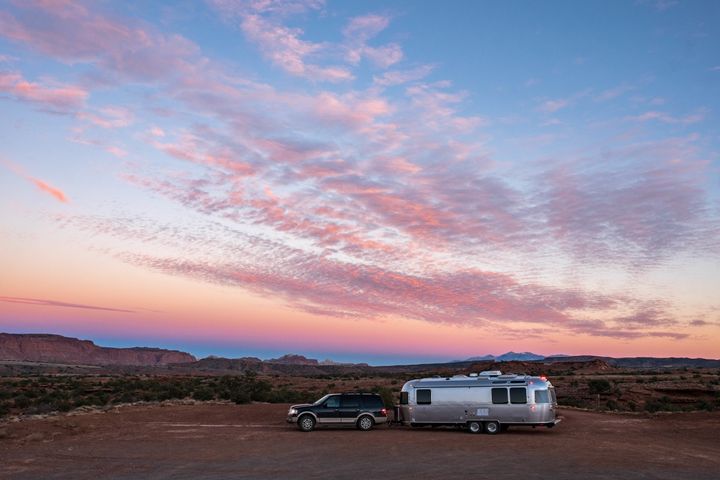
Wally the Airstream at Panorama Point.
CATHEDRAL VALLEY
The Cathedral Valley area is a backcountry dream where you can get lost in solitude while exploring Utah's rugged and remote wilderness ecosystems. Not only is the Cathedral Valley area completely stunning, but its far-flung location is infrequently visited allowing visitors a respite from crowds found in more accessible areas. There is much to see and do in the Cathedral Valley – driving on primitive roads under big skies, shooting the sunrise at cool formations like the Temple of the Sun, Moon, and Stars, camping and hiking with peace and quiet as your guides... it’s amazing out there!
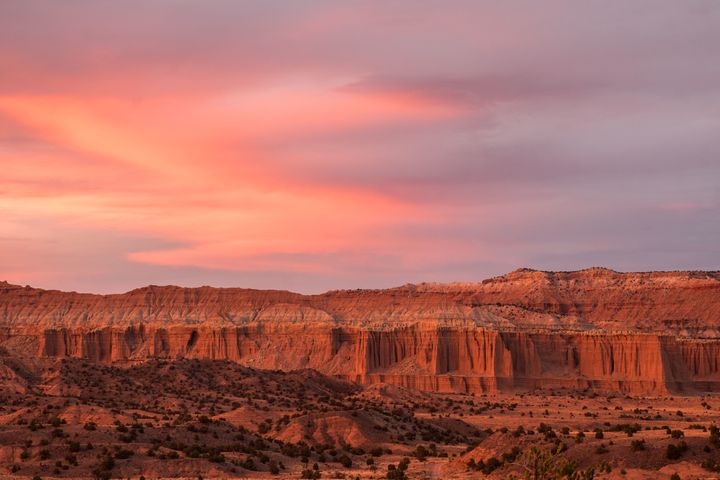
Red rock in the crepescule of a richly colored November night.
Glass Mountain
One of the coolest sites in the national park is the Glass Mountain, a small formation of exposed gypsum made of selenite crystals. The textured mound looks like it is decorated by broad brush stokes of dirt exposing glassy crystals. You can find it next to the Temple of the Moon monolith, and plan for at least 30 minutes to explore it. Even though it is relatively small when compared to other features in the park, and climbing on its delicate gem is forbidden, it is so unique and interesting that you will probably find yourself doing laps around it, spellbound by the incredible textured shapes of the gypsum.
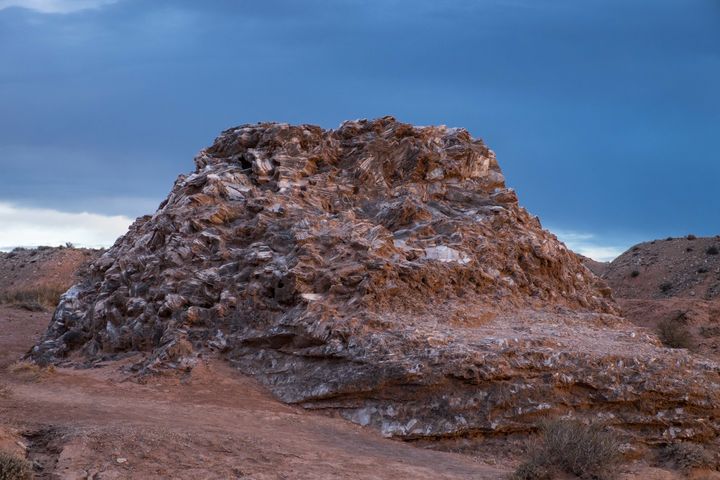
Selenite crystals form Glass Mountain.
Gypsum Sinkhole
Five miles from the Cathedral Valley campground is the Gypsum Sinkhole – a 200-foot deep, 50-foot wide chasm that formed when water dissolved the below-ground gypsum foundation, allowing the site to cave in. It is astounding to stand over and look down into a depression like this falling so deep into the Earth, a reminder of the forces of nature always at work beneath the planetary surface.
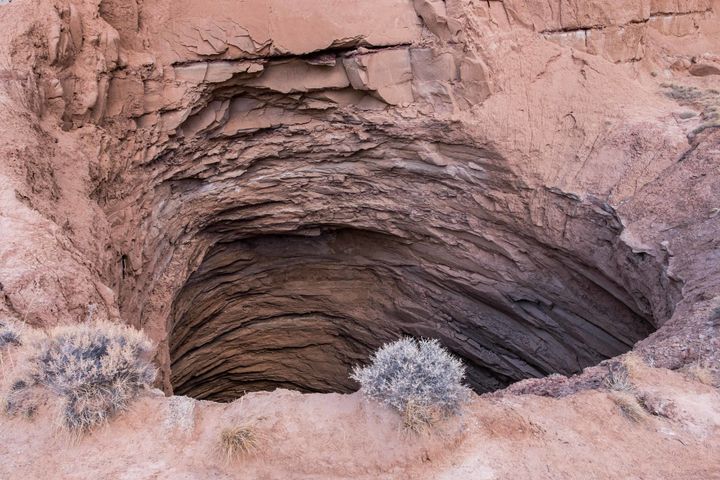
Entrance to the 200 feet chasm.
Morrell Cabin
The historic Morrell Cabin and Corral in Cathedral Valley sheds light onto how this area has been used during the last century. It was built in the 1920s on Thousand Lake Mountain by a wealthy landowner named Paul Christensen, and was moved during the 1930s to its current location in the Cathedral Valley by Lesley Morrell. Locally known as “Les’s Cabin,” it once served as a stop along for cattle ranchers traveling to and from Thousand Lake Mountain where they could eat, sleep, rest and refuel. The National Park Service purchased the site in 1970. It is listed today on the National Registrar of Historic Places.
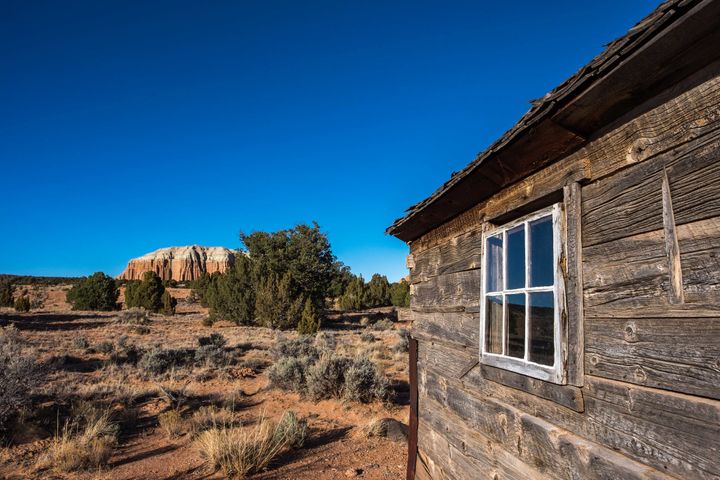
Morrell Cabin in the Cathedral Valley.
WATERPOCKET FOLD
Waterpocket Fold, the geologic feature, is a 100-mile rocky spine extending from Thousand Lake Mountain to Lake Powell. Its technical name is a monocline, which, citing the Oxford Dictionary is a 'bend in rock strata that is otherwise uniformly dipping or horizontal.'
Waterpocket Fold, the area, is the least visited section of the national park. It has few services and few marked trails which is of course highly enticing for backpackers who want to head out into the wilderness to get lost. We weren’t able to make it to the Fold but from what we read and learned there, the Halls Creek Narrows and the Lower Muley Twist Canyon are two of the most popular spots in the park to set off from on a backpacking adventure... and so it goes, like so many other places found on our quest to see all of the national parks during 2016, we're adding this area to the lengthy list of places to explore in the future!

Highway 24 into Capitol Reef National Park in Southern Utah... epic!
